This week in new #1 releases – and in our new Friday time slot – we’ve got tales of D’jinn and Jedi alike, new series from some childhood favorite franchises, and a whole slew of interesting female characters leading the way.
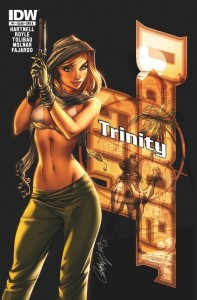 IDW’s Danger Girl: Trinity #1 is an all-female espionage thriller, providing a new jumping off point for all three of its heroines with separate story arcs within the same book, each from a different artist. For those unfamiliar, Danger Girl debuted in 1998, created by J. Scott Campbell and writer Andy Hartnell who penned this issue as well. These tales of female spies and adventurers are influenced both by 007 and Indiana Jones. (The opening scene of Trinity is practically copied from Harrison Ford’s opening action scene in Indiana Jones and the Last Crusade, complete with an ancient artifact and an exploding freighter.) The three Danger Girls of the title – Abby Chase, and the sisters Sydney and Sonja Savage – are tough and determined, from recovering treasure on the high seas to bounty hunting in the deepest jungles. You have to admire three women who can hold their own against thugs and assassins, but unfortunately, I can’t help but wish that they weren’t introduced to the audience in such a hyper-sexualized way. Many feminists see nothing wrong with using femininity and sexuality as a source of empowerment, but in this book it’s tough to tell if that’s the case, or if the artists are merely exploiting a certain demographic by showing the women in their underwear or scanty leather bustiers. The same criticism can be applied to the next two titles reviewed her. In this instance, the blurry line left me with little remembrance of the plot of DG:Trinity, merely an hour after finishing the book, and that ultimately puts me off the title going forward. I’ve been wrong before, however, and my mind may change.
IDW’s Danger Girl: Trinity #1 is an all-female espionage thriller, providing a new jumping off point for all three of its heroines with separate story arcs within the same book, each from a different artist. For those unfamiliar, Danger Girl debuted in 1998, created by J. Scott Campbell and writer Andy Hartnell who penned this issue as well. These tales of female spies and adventurers are influenced both by 007 and Indiana Jones. (The opening scene of Trinity is practically copied from Harrison Ford’s opening action scene in Indiana Jones and the Last Crusade, complete with an ancient artifact and an exploding freighter.) The three Danger Girls of the title – Abby Chase, and the sisters Sydney and Sonja Savage – are tough and determined, from recovering treasure on the high seas to bounty hunting in the deepest jungles. You have to admire three women who can hold their own against thugs and assassins, but unfortunately, I can’t help but wish that they weren’t introduced to the audience in such a hyper-sexualized way. Many feminists see nothing wrong with using femininity and sexuality as a source of empowerment, but in this book it’s tough to tell if that’s the case, or if the artists are merely exploiting a certain demographic by showing the women in their underwear or scanty leather bustiers. The same criticism can be applied to the next two titles reviewed her. In this instance, the blurry line left me with little remembrance of the plot of DG:Trinity, merely an hour after finishing the book, and that ultimately puts me off the title going forward. I’ve been wrong before, however, and my mind may change.
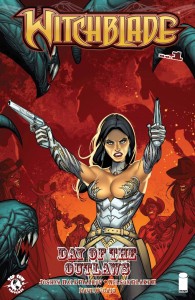 Many of the same things could be said about Witchblade: Day of the Outlaws #1, from Top Cow and Image. Also featuring a female lead, here we meet the Native American Sheriff of a small town in the Colorado hills in 1878. The idea that such an event could have occurred in the Old West of the time borders on science fiction. Sheriff Enola is an early wielder of The Witchblade and that has helped her win the job, apparently. Her use of the arcane power is a secret that she hasn’t guarded closely enough, however. When she’s discovered using her magical weapon against an outlaw, she is ostracized and left to die in the barren winter wilderness, until outlaws possessing The Darkness ride into town. While the local preacher changes his tune in a hurry, Enola isn’t entirely motivated to save those she once protected. The issues of treatment of women (and Native American people in particular) are much more front and center in this book. This is a nice one-shot adventure for fans of Top Cow’s mainstay titles Witchblade and The Darkness, but the underlying themes of fair treatment and equality are valid reasons to pick up the book, even if you know nothing of the stories.
Many of the same things could be said about Witchblade: Day of the Outlaws #1, from Top Cow and Image. Also featuring a female lead, here we meet the Native American Sheriff of a small town in the Colorado hills in 1878. The idea that such an event could have occurred in the Old West of the time borders on science fiction. Sheriff Enola is an early wielder of The Witchblade and that has helped her win the job, apparently. Her use of the arcane power is a secret that she hasn’t guarded closely enough, however. When she’s discovered using her magical weapon against an outlaw, she is ostracized and left to die in the barren winter wilderness, until outlaws possessing The Darkness ride into town. While the local preacher changes his tune in a hurry, Enola isn’t entirely motivated to save those she once protected. The issues of treatment of women (and Native American people in particular) are much more front and center in this book. This is a nice one-shot adventure for fans of Top Cow’s mainstay titles Witchblade and The Darkness, but the underlying themes of fair treatment and equality are valid reasons to pick up the book, even if you know nothing of the stories.
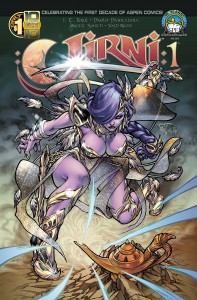 Ladies with nasty blades are a bit of a theme this week, and next up is Jirni #1 from Aspen Comics, written by J.T. Krul with art by Paolo Pantalena. Aspen is a publisher with a history of warrior women in its books (they’re the folks behind the oft-deplorable Executive Assistants series). They’re doing a touch better in this book with Ara, a warrior princess in possession of mystical gifts she doesn’t quite understand. Ara can become a very powerful (and very purple) magical sword-wielding mega-badass, searching for her mother across the barren landscape of her fantasy world. Taken as a hostage by a mysterious sorcerer and his powerful D’jinn in a bottle, Ara’s mother was the queen of Ara’s homeland, and seems to hold the key to her daughter’s mysterious gifts. There’s a real depth to Ara’s childhood backstory and her bond with her now lost mother. She has the drive that many of the other women we’ve seen this week do not, a strong connection to family, and a desire to protect them and other innocents she encounters, rather than a simple love of adventure or glory. She’s also introduced to us sword in hand, jumping into the melee, and not as a sexual object, regardless of her impractically skimpy attire, which is as refreshing a change as we’ve had this week.
Ladies with nasty blades are a bit of a theme this week, and next up is Jirni #1 from Aspen Comics, written by J.T. Krul with art by Paolo Pantalena. Aspen is a publisher with a history of warrior women in its books (they’re the folks behind the oft-deplorable Executive Assistants series). They’re doing a touch better in this book with Ara, a warrior princess in possession of mystical gifts she doesn’t quite understand. Ara can become a very powerful (and very purple) magical sword-wielding mega-badass, searching for her mother across the barren landscape of her fantasy world. Taken as a hostage by a mysterious sorcerer and his powerful D’jinn in a bottle, Ara’s mother was the queen of Ara’s homeland, and seems to hold the key to her daughter’s mysterious gifts. There’s a real depth to Ara’s childhood backstory and her bond with her now lost mother. She has the drive that many of the other women we’ve seen this week do not, a strong connection to family, and a desire to protect them and other innocents she encounters, rather than a simple love of adventure or glory. She’s also introduced to us sword in hand, jumping into the melee, and not as a sexual object, regardless of her impractically skimpy attire, which is as refreshing a change as we’ve had this week.
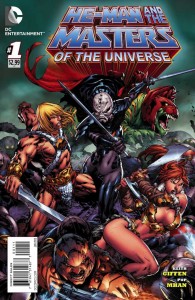 While still bearing a man’s name on the cover, DC’s He-Man and The Masters of the Universe #1 introduces us to our last sword wielding lady this week. This is hardly a beginning, but yet another re-launch in the numbering of a title that’s already been running for a while, and it’s painfully obvious from the start. Prince Adam, the alter ego of He-Man (which I would not have known, had I not been a child of the 80’s), and his friends begin the issue mourning the loss of a great sorceress. He-Man and his friends have also apparently defeated Skeletor, and his traditional nemesis is nowhere to be seen in this book. There is a great deal of discussion of the death of several magicians and sorcerers that makes little sense to anyone who hasn’t been reading along already. This is not a good point for jumping into the story, but it does feature two rather tough women, He-Man’s companion Teela, and the villainess Despara, who actually is She-Ra in a retelling of her origin story from the TV show. Teela here is also her younger sister, a sassy young woman who doesn’t put up with the insults or jibes of the men around her, refusing to listen to so much as a simple quip about dying her hair unexpectedly, and not letting anyone belittle her fighting skills. Still, she seems to feel perfectly at ease stripping out of her clothes into her underwear after the funeral she attends with Prince Adam and her father. It’s an action so hugely out of character, it can’t be viewed as anything other than exploitative by the artist here in an already unimaginative retelling of She-Ra’s origin story.
While still bearing a man’s name on the cover, DC’s He-Man and The Masters of the Universe #1 introduces us to our last sword wielding lady this week. This is hardly a beginning, but yet another re-launch in the numbering of a title that’s already been running for a while, and it’s painfully obvious from the start. Prince Adam, the alter ego of He-Man (which I would not have known, had I not been a child of the 80’s), and his friends begin the issue mourning the loss of a great sorceress. He-Man and his friends have also apparently defeated Skeletor, and his traditional nemesis is nowhere to be seen in this book. There is a great deal of discussion of the death of several magicians and sorcerers that makes little sense to anyone who hasn’t been reading along already. This is not a good point for jumping into the story, but it does feature two rather tough women, He-Man’s companion Teela, and the villainess Despara, who actually is She-Ra in a retelling of her origin story from the TV show. Teela here is also her younger sister, a sassy young woman who doesn’t put up with the insults or jibes of the men around her, refusing to listen to so much as a simple quip about dying her hair unexpectedly, and not letting anyone belittle her fighting skills. Still, she seems to feel perfectly at ease stripping out of her clothes into her underwear after the funeral she attends with Prince Adam and her father. It’s an action so hugely out of character, it can’t be viewed as anything other than exploitative by the artist here in an already unimaginative retelling of She-Ra’s origin story.
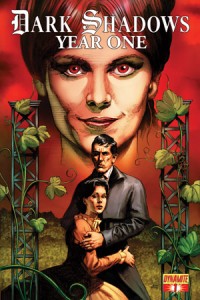 We wander only slightly out of the realms of fantasy and classic TV with Dark Shadows Year One #1 from Dynamite Entertainment. This retelling of the tale of one Barnabas Collins, vampire, doesn’t go for the mirth of the recent Johnny Depp/Tim Burton film had, but instead treats its mid-19th century hero with grave reverence. Artist Guiu Vilanova also manages to avoid traps set by the bulging-bodice-era-setting in this story. Barnabas is on the eve of marriage to his one true love, when the witch Angelique – who turns out to also be his betrothed’s handmaiden – seduces him. Here, Barnabas is seen less as an innocent victim and more as a womanizer whose last mistake may cost him more dearly than he ever expected. While Angelique is a somewhat flat character, seemingly an evil witch for evil’s sake, she does have something of a point. On the eve of his wedding, Barnabas freely went to bed with her, and while she uses magical means to bring others under her sphere of influence, he went there willingly in his first encounter with her. She further manipulates him into killing his favorite uncle Jeremiah in a duel. Jeremiah might have had it coming, as he encourages Barnabas in his indiscretion as “a matter of tradition” and isn’t afraid to violently intimidate a woman to keep her quiet. Hopefully, there will be more of Angelique’s backstory and her motivations.
We wander only slightly out of the realms of fantasy and classic TV with Dark Shadows Year One #1 from Dynamite Entertainment. This retelling of the tale of one Barnabas Collins, vampire, doesn’t go for the mirth of the recent Johnny Depp/Tim Burton film had, but instead treats its mid-19th century hero with grave reverence. Artist Guiu Vilanova also manages to avoid traps set by the bulging-bodice-era-setting in this story. Barnabas is on the eve of marriage to his one true love, when the witch Angelique – who turns out to also be his betrothed’s handmaiden – seduces him. Here, Barnabas is seen less as an innocent victim and more as a womanizer whose last mistake may cost him more dearly than he ever expected. While Angelique is a somewhat flat character, seemingly an evil witch for evil’s sake, she does have something of a point. On the eve of his wedding, Barnabas freely went to bed with her, and while she uses magical means to bring others under her sphere of influence, he went there willingly in his first encounter with her. She further manipulates him into killing his favorite uncle Jeremiah in a duel. Jeremiah might have had it coming, as he encourages Barnabas in his indiscretion as “a matter of tradition” and isn’t afraid to violently intimidate a woman to keep her quiet. Hopefully, there will be more of Angelique’s backstory and her motivations.
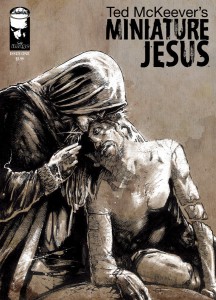 The path of this weeks #1’s reaches a fork in the road. To the left, we head into deeply surreal territory, with two titles that push the edges of imagination. First is Miniature Jesus #1 from Image, written and starkly drawn in black and white by Ted McKeaver. Indeed, stark is a good word for most of this story, a tale of a drifting loner struggling with some unusual representations of the all too real demon of alcoholism. Trying to keep his desires in check, the main character has hallucinatory conversations with the reanimated corpse of a dead cat and his own inner demon given form and cloudy life. As he wanders through the countryside, as if hoping never to be found, we also encounter a small town preacher. His fire and brimstone sermon, given to an audience of one small child, suddenly awakens the crucifix in his church, breathing life into a miniature depiction of Jesus. The fantastical suddenness with which the Christ figure comes alive leaves us instantly questioning what in this book is really in the mind of its characters, and what’s in the real world. Alas, there’s not enough in the narrative that binds these people together, or makes us care enough about them to follow the book further. It has the feel of an eccentric music video that’s meant to convey mood more than story, but fails to even deliver an accurate feel of what that mood even is.
The path of this weeks #1’s reaches a fork in the road. To the left, we head into deeply surreal territory, with two titles that push the edges of imagination. First is Miniature Jesus #1 from Image, written and starkly drawn in black and white by Ted McKeaver. Indeed, stark is a good word for most of this story, a tale of a drifting loner struggling with some unusual representations of the all too real demon of alcoholism. Trying to keep his desires in check, the main character has hallucinatory conversations with the reanimated corpse of a dead cat and his own inner demon given form and cloudy life. As he wanders through the countryside, as if hoping never to be found, we also encounter a small town preacher. His fire and brimstone sermon, given to an audience of one small child, suddenly awakens the crucifix in his church, breathing life into a miniature depiction of Jesus. The fantastical suddenness with which the Christ figure comes alive leaves us instantly questioning what in this book is really in the mind of its characters, and what’s in the real world. Alas, there’s not enough in the narrative that binds these people together, or makes us care enough about them to follow the book further. It has the feel of an eccentric music video that’s meant to convey mood more than story, but fails to even deliver an accurate feel of what that mood even is.
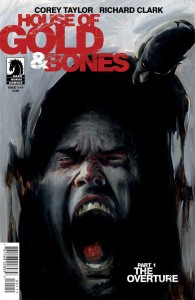 Dark Horse follows down the surreal path with House of Gold and Bones #1, from Slip Knot and Stone Sour vocalist Corey Taylor. This is an equally unusual story about a man trapped in a dream he has trouble believing isn’t real. He’s pursued by an enigmatic evil known as Black John, and tormented by an equally demented doppelganger known only as Allen, as he searches for the titular House. Why he does so is unclear, even to him, and the narrative, while as unusual as Miniature Jesus #1 is even less compelling.This is largely a failing of the artistic style here, which is much more realistic and done in full color. The book looks to have been illustrated with a traditional super-hero comic aesthetic, and the art detracts from the fantastical nature of the story. The book would have been better served had it been drawn in the style of cover artist Jason Shawn Alexander’s dark homage to The Scream.
Dark Horse follows down the surreal path with House of Gold and Bones #1, from Slip Knot and Stone Sour vocalist Corey Taylor. This is an equally unusual story about a man trapped in a dream he has trouble believing isn’t real. He’s pursued by an enigmatic evil known as Black John, and tormented by an equally demented doppelganger known only as Allen, as he searches for the titular House. Why he does so is unclear, even to him, and the narrative, while as unusual as Miniature Jesus #1 is even less compelling.This is largely a failing of the artistic style here, which is much more realistic and done in full color. The book looks to have been illustrated with a traditional super-hero comic aesthetic, and the art detracts from the fantastical nature of the story. The book would have been better served had it been drawn in the style of cover artist Jason Shawn Alexander’s dark homage to The Scream.
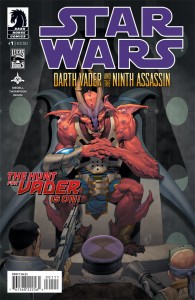 Down the other path we find something familiar to fall back on, with science-fiction franchises. Star Wars: Darth Vader and the Ninth Assassin #1 is the most recent mini-series from Dark Horse to follow the activities of our favorite Dark Lord of the Sith, just after his transformation in Episode III. It’s a stand-alone story about a wealthy mining magnate who attempts to hire killers to destroy Vader for murdering his son, and the first issue sees him hiring the titular Ninth nasty to try to get the job done. It’s mostly a set-up for the larger story, however, of the unnamed man’s attempts to find the assassin’s lair, and the terrible price he pays seeking his revenge. Sadly, we all know he won’t be successful, so ultimately the story does little except remind us what a badass Darth Vader really was, which frankly, we all knew to begin with. This series is just another cautionary – be careful what you wish for – and like other Episode III aftermath series before it, falls short of what we expect from the Star Wars franchise.
Down the other path we find something familiar to fall back on, with science-fiction franchises. Star Wars: Darth Vader and the Ninth Assassin #1 is the most recent mini-series from Dark Horse to follow the activities of our favorite Dark Lord of the Sith, just after his transformation in Episode III. It’s a stand-alone story about a wealthy mining magnate who attempts to hire killers to destroy Vader for murdering his son, and the first issue sees him hiring the titular Ninth nasty to try to get the job done. It’s mostly a set-up for the larger story, however, of the unnamed man’s attempts to find the assassin’s lair, and the terrible price he pays seeking his revenge. Sadly, we all know he won’t be successful, so ultimately the story does little except remind us what a badass Darth Vader really was, which frankly, we all knew to begin with. This series is just another cautionary – be careful what you wish for – and like other Episode III aftermath series before it, falls short of what we expect from the Star Wars franchise.
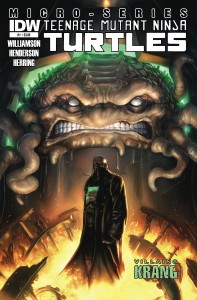 A rather unexpected villain gets the star treatment in Teenage Mutant Ninja Turtles: Villains Micro-Series #1. The main character here is the somewhat obscure TMNT villain General Krang, the brain with a face who occupied a powerful robot body and allied himself with Shredder. However, we see neither Shredder not the Ninja Turtles in this story, and that turns out to be just fine. This is Krang’s tale and he tells it well. Krang was raised in Dimension X by an imperious father who ruled their word. Krang’s father perceived Krang as a spoiled rich kid, or rich brain, I suppose. The tale retcons the character a bit by establishing the brain-like structure as the true form of Kang’s people. To earn his father’s respect, he stows away aboard an Army ship headed into battle with his father’s greatest enemy, but Krang is stranded on the hostile planet after the entire unit is wiped out. He learns to survive in the jungle on his own, and eventually single-handedly dispatches his father’s enemy and earns his father’s respect. his kind of tale, while ridiculous in certain aspects (did I mention that he’s a walking brain?) is a welcome fleshing out of a formerly flat character, and with Michael Bay’s determination to unleash yet another of our childhood toy franchises on us in film format sometime soon, it seems to be setting us up for a return of Krang to the TMNT villains gallery.
A rather unexpected villain gets the star treatment in Teenage Mutant Ninja Turtles: Villains Micro-Series #1. The main character here is the somewhat obscure TMNT villain General Krang, the brain with a face who occupied a powerful robot body and allied himself with Shredder. However, we see neither Shredder not the Ninja Turtles in this story, and that turns out to be just fine. This is Krang’s tale and he tells it well. Krang was raised in Dimension X by an imperious father who ruled their word. Krang’s father perceived Krang as a spoiled rich kid, or rich brain, I suppose. The tale retcons the character a bit by establishing the brain-like structure as the true form of Kang’s people. To earn his father’s respect, he stows away aboard an Army ship headed into battle with his father’s greatest enemy, but Krang is stranded on the hostile planet after the entire unit is wiped out. He learns to survive in the jungle on his own, and eventually single-handedly dispatches his father’s enemy and earns his father’s respect. his kind of tale, while ridiculous in certain aspects (did I mention that he’s a walking brain?) is a welcome fleshing out of a formerly flat character, and with Michael Bay’s determination to unleash yet another of our childhood toy franchises on us in film format sometime soon, it seems to be setting us up for a return of Krang to the TMNT villains gallery.
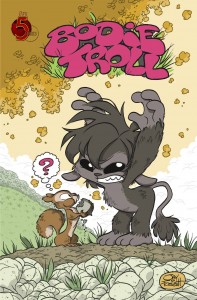 After all that, we’ve saved the best for last this week. Of all the fantasy tales this week, none had the compelling story telling or precocious humor of Bodie Troll #1. Bodie is a young troll who is simply too cuddly and adorable for his own good. His only desire in life is to rule over his bridge and scare those who try to cross it, but he’s so loveable that no one takes him seriously. Bodie makes his living running errands for the local fairy god-mother, and spending time with is friend, the bar maid Cholly. Bodie has a crush on Cholly the way 1st graders have a crush on their teachers, and his innocent nature is the essence of the whole book. He’s content to run errands in exchange for his favorite meal of dirty ground roots (rolled on the floor a few extra times for good measure) and proves an unlikely hero when a true monster shows his face. In the best 1st grade fashion, it turns out Bodie’s secret weapon against the beast is his own pee. The slightly bawdy humor permeates this delightful children’s comic, bringing laughs and warmth to a genre often so syrupy sweet it can barely be tolerated. Bodie is a youngster finding his path in the world, with a determined eye on what he thinks he’s supposed to be, all the while establishing himself as something else entirely. At heart, Bodie is a young kid looking for adventure, and the charm with which he finds it is captivating and uplifting.
After all that, we’ve saved the best for last this week. Of all the fantasy tales this week, none had the compelling story telling or precocious humor of Bodie Troll #1. Bodie is a young troll who is simply too cuddly and adorable for his own good. His only desire in life is to rule over his bridge and scare those who try to cross it, but he’s so loveable that no one takes him seriously. Bodie makes his living running errands for the local fairy god-mother, and spending time with is friend, the bar maid Cholly. Bodie has a crush on Cholly the way 1st graders have a crush on their teachers, and his innocent nature is the essence of the whole book. He’s content to run errands in exchange for his favorite meal of dirty ground roots (rolled on the floor a few extra times for good measure) and proves an unlikely hero when a true monster shows his face. In the best 1st grade fashion, it turns out Bodie’s secret weapon against the beast is his own pee. The slightly bawdy humor permeates this delightful children’s comic, bringing laughs and warmth to a genre often so syrupy sweet it can barely be tolerated. Bodie is a youngster finding his path in the world, with a determined eye on what he thinks he’s supposed to be, all the while establishing himself as something else entirely. At heart, Bodie is a young kid looking for adventure, and the charm with which he finds it is captivating and uplifting.

